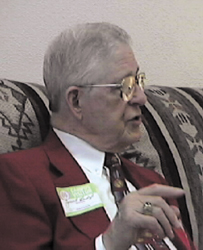|
“I
was patriotic and proud to serve my country...”
|
|
 |
 |
|
Eight
years Away from Home
|
|
|
-An
oral history of James Hodges
|
Home | Table of Contents | Previous Story | Next Story
Personal Profile | Audio Interview
|
James Hodges thought that joining the Texas National Guard in 1936 would be a good way to help his family stay afloat during the Great Depression; but he had no idea that he would be able to help his country triumph over some of its greatest foes at the same time. When the Texas National Guard mobilized on November 25, 1940, Mr. Hodges had to leave his new wife and month-old baby to serve for one year. Shortly after he returned from his year of service, Japan bombed Pearl Harbor and the U.S. went to war.
Six months later, Mr. Hodges found himself with the 176th Engineers aboard the S.S. William L. Thompson headed for Valdez, Alaska. Rumor had it that a submarine had sunk a supply ship traveling just ahead of his ship, so when he and another shipmate began their watch duty, they were quite jumpy and nervous. Suddenly, he recalls, “a submarine [came] up out of the water . . . and just scared the daylights out of me.” Despite that scare, Mr. Hodges’s ship made it to Alaska without being sunk. There he helped construct Army camps before winter set in. After
some time in Alaska, Virginia, North Carolina, and Washington, Mr. Hodges
was assigned to an advanced detail and accompanied the USS General A.E. Anderson,
a troop transport, to Australia. Leaving from the San Francisco Bay was a
memorable experience for him. Security was tight, and tugboats had to lead
the transport out of the bay and open the “submarine net.” Mr. Hodges remembers
asking a friend, “Do you think we’ll ever see this place again?” as the ship
pulled out into open waters. About a week later something happened that made Mr. Hodges fear the answer to his question might be “No.” One afternoon during lunch, “the ship made a real quick turn and listed to one side,” he says. “I was in the mess hall at that time, and cups, saucers, and all that stuff just slid down the table.” The ship’s radio burst with sound as the captain announced, “Now hear this . . . We’ve had a submarine alert . . . Buckle up your life jackets.” Mr. Hodges recalls a “bomber circling the ship twice and then leaving, and [him] not [knowing] if there was an actual submarine.” From Australia, Mr. Hodges was transferred to Bombay, India in November 1944, and then to Iran, where his duties were mainly basic maintenance. He remained in Iran until the war in Europe ended in May 1945. Because Mr. Hodges had enough service points, he was able to return to the United States almost immediately after peace was declared. Although he was scheduled to be discharged from the Army on December 6, 1945, Mr. Hodges reenlisted because he feared he could not support his family without a vocation or a high school diploma. He says in retrospect, “I did not realize it, but I had done something very bad, not only to my family, but also to me.” In 1946, Mr. Hodges was sent to Korea as a member of the Army of Occupation. At last in 1948, he left the Army for good and returned to his family and the Heights. “I got tired of being in the military,” he says, “and mainly I got tired of being away from my family. We didn’t have much of a family life for eight years.” In 1950, Mr. Hodges completed John H. Reagan senior high school after attending night school and working during the day. When asked what the difference was between the real war and the war as portrayed in movies, he replies, “The real war—I was fortunate. I didn’t get into that.” |
 In
January of 1942, Mr. Hodges “got a letter in the mail that had red around
it . . . recalling [him] into the service.” He had thought that after his
year of service with the Texas National Guard he could not be recalled, but
he soon discovered that when he left the National Guard he was given a “Certificate
of Service” instead of the discharge necessary to exempt him from additional
service. Mr. Hodges reported to Fort Sam Houston and found that his old division—the
36th Infantry Division—had been restructured, so he was transferred to the
176th Engineers GS Regiment. “Some-time I think that was a blessing,” he says,
“because what they [the 36th] went through was a terrible, terrible thing.
Many of these men I went in with were killed in World War II.”
In
January of 1942, Mr. Hodges “got a letter in the mail that had red around
it . . . recalling [him] into the service.” He had thought that after his
year of service with the Texas National Guard he could not be recalled, but
he soon discovered that when he left the National Guard he was given a “Certificate
of Service” instead of the discharge necessary to exempt him from additional
service. Mr. Hodges reported to Fort Sam Houston and found that his old division—the
36th Infantry Division—had been restructured, so he was transferred to the
176th Engineers GS Regiment. “Some-time I think that was a blessing,” he says,
“because what they [the 36th] went through was a terrible, terrible thing.
Many of these men I went in with were killed in World War II.”